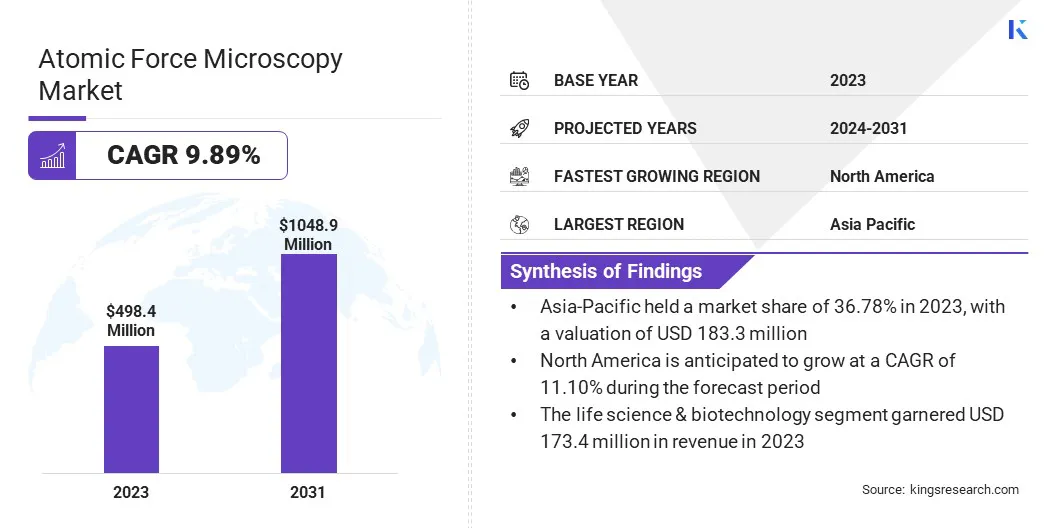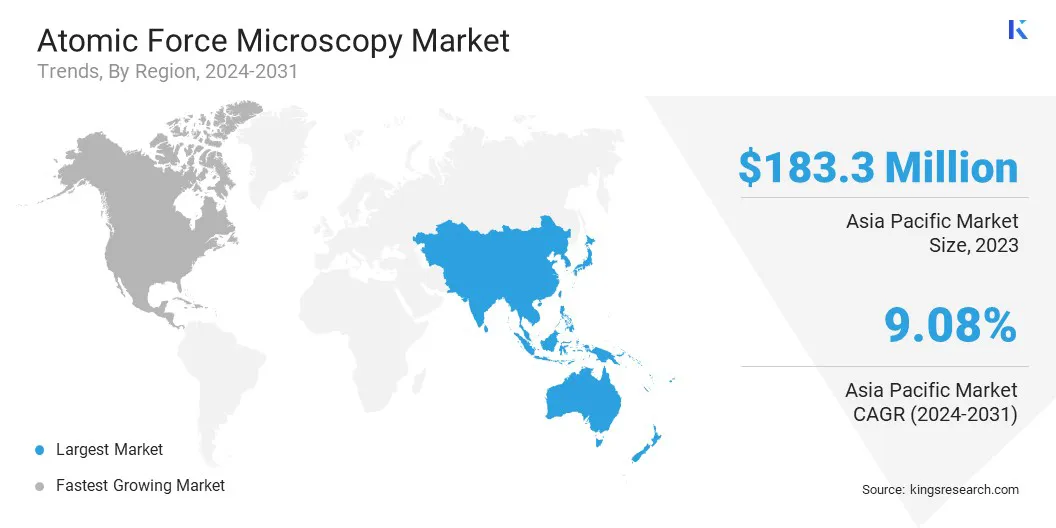Atomic Force Microscopy Market Size
The Atomic Force Microscopy Market size was valued at USD 498.4 million in 2023 and is projected to grow from USD 542.1 million in 2024 to USD 1,048.9 million by 2031, exhibiting a CAGR of 9.89% during the forecast period. The market is expanding due to the growing emphasis on precision in semiconductor fabrication and the development of advanced materials.
Rising investments in research infrastructure and increased focus on nanomedicine are further supporting this growth. Additionally, the emergence of AFM in emerging applications, such as environmental monitoring and forensic analysis, is influencing the dynamic evolution of the market.
In the scope of work, the report includes solutions offered by companies such as Park Systems, Hitachi High-Tech Corporation., Nanonics Imaging ltd, Bruker, Keysight Technologies, Oxford Instruments, Nanosurf, Horiba, Ltd., NT‑MDT SPECTRUM INSTRUMENTS, Semilab Inc., and others.
The atomic force microscopy market is witnessing significant growth due to rising demand across various fields, including nanotechnology, materials science, and biotechnology. The shift toward high-resolution imaging and precise nanoscale measurements is fueling market expansion. Technological advancements in AFM, such as improved resolution and multifunctional features, are further aiding market growth.
- For instance, in May 2024, Oxford Instruments Asylum Research launched AR Maps, an advanced data analysis software for the Jupiter XR AFM. AR Maps provides ISO-standard roughness information, statistical reports, critical dimension and trench analysis, and particle analysis. The software is anticipated to be included with new Jupiter XR AFM systems and is likely to be available as an upgrade for current users, highlighting significant advancements in AFM technology.
The integration of AFM with other analytical techniques, such as scanning tunneling microscopy and Raman spectroscopy, is broadening its applications and enhancing material characterization. Additionally, the increasing use of atomic force microscopy in advanced manufacturing processes, such as 3D integrated circuits, is propelling the expansion of the market.
Atomic force microscopy is a high-resolution imaging technique that provides a detailed analysis of surfaces at the nanoscale. By scanning a sharp tip, typically made of silicon or silicon nitride, across a sample's surface, AFM measures the atomic forces between the tip and the surface. These measurements generate topographical maps and offer insights into surface properties such as roughness, mechanical behavior, and electrical characteristics.
Atomic force microscopy, widely used in materials science, nanotechnology, and biology, allows for precise, three-dimensional imaging and analysis at the atomic level, which makes it an essential tool for researchers and industry professionals aiming to understand and manipulate nanoscale materials.

Analyst’s Review
The atomic force microscopy market is set to experience rapid growth, fueled by advancements in nanotechnology applications within semiconductor manufacturing and life sciences. Major industry players are leveraging strategic mergers and acquisitions to capitalize on this rising demand, with the aim of enhancing competitiveness and fostering innovation in nanotechnology applications.
- For instance, in September 2022, Park Systems, a leading player in the market, acquired Accurion GmbH to broaden its technology portfolio and strengthen its position in the global market.
This strategic approach underscores key players’ commitment to enhancing capabilities and addressing the evolving dynamics within the global atomic force microscopy landscape.
Atomic Force Microscopy Market Growth Factors
The expanding application of nanotechnology across diverse fields such as materials science, electronics, and biotechnology is significantly increasing the demand for atomic force microscopy. As these industries continue to explore and innovate at the nanoscale, the need for high-resolution imaging and precise measurements becomes increasingly critical.
AFM offers unparalleled capabilities for observing and manipulating materials at this tiny scale, allowing researchers to study surface topography, mechanical properties, and molecular interactions with exceptional accuracy. This capability is crucial for advancing nanotechnology applications, including the development of new materials and devices and the enhancement of biological research, thereby fueling market growth.
A significant challenge impeding the development of the atomic force microscopy market is the high cost and complexity of the equipment, which limit accessibility for smaller research institutions and emerging markets. Additionally, the advanced technical expertise required to operate and interpret AFM data poses a significant barrier.
Key players are mitigating these challenges by developing more cost-effective AFM models and providing extensive training and support programs. Furthermore, companies are investing heavily in user-friendly software and automation features to simplify operation and data analysis, making AFM technology more accessible and easier to use for a wider range of researchers and institutions.
Atomic Force Microscopy Market Trends
A notable trend in the atomic force microscopy market is the growing integration of AFM with other analytical techniques, such as scanning tunneling microscopy (STM) and Raman spectroscopy. This integration facilitates a more comprehensive approach to material characterization by combining the strengths of each technique.
While AFM provides detailed surface topography and mechanical property measurements at the nanoscale, STM offers insights into electronic properties and surface conductivity, and Raman spectroscopy delivers information on molecular vibrations and chemical compositions. By expanding the range of analysis capabilities, this trend is making AFM a more versatile tool in research and industry, thus fostering market growth.
- Oxford Instruments Asylum Research introduced the Cypher L atomic force microscope (AFM) in July 2022. This cutting-edge AFM is specifically designed for researchers across a variety of fields, such as polymers, 2D materials, quantum technologies, and energy storage, who require basic AFM skills. This new addition highlights the continuous innovation and expansion of AFM technology, addressing the diverse needs of the scientific community and bolstering market growth.
The increasing use of atomic force microscopy in the manufacturing of three-dimensional (3D) integrated circuits (ICs) is contributing significantly to market growth. As multiple layers of active electronic components are stacked to create compact, high-performance devices, the need for precise measurement and analysis becomes increasingly crucial.
AFM's ability to provide detailed imaging and accurate characterization at the nanoscale enables IC manufacturers to optimize fabrication processes, enhance quality assurance, and conduct effective failure analysis. This advanced capability supports the development of more reliable and efficient 3D ICs, leading to increased demand for AFM systems and supporting the expansion of the market.
Segmentation Analysis
The global market is segmented based on application, grade, and geography.
By Application
Based on application, the market is categorized into materials science & characterization, life science & biotechnology, semiconductors & electronics, academics, and others. The life science & biotechnology segment garnered the highest revenue of USD 173.4 million in 2023.
AFM's ability to provide high-resolution imaging and precise measurements at the nanoscale makes it indispensable for studying biological samples, including cells, proteins, and DNA. Researchers in these fields use AFM to investigate the mechanical properties and structural details of biomolecules, which contributes to advancements in drug development, genetic research, and disease diagnostics.
The increasing investment in biotechnology research and the growing emphasis on nanomedicine and personalized medicine are boosting the demand for AFM in the field of life science & biotechnology.
By Grade
Based on grade, the market is categorized into research grade and industrial grade. The industrial grade segment captured the largest atomic force microscopy market share of 54.33% in 2023. Industrial-grade AFM systems are essential in sectors such as semiconductor manufacturing, materials science, and nanotechnology, where precise surface characterization and defect analysis are critical.
These advanced AFM systems offer robust performance, high-resolution imaging, and the ability to operate in harsh industrial environments. They are used to optimize manufacturing processes, ensure quality control, and enhance product reliability. The increasing demand for miniaturized electronic components and advanced materials is boosting the adoption of industrial-grade AFM, thereby contributing to segmental growth.
Atomic Force Microscopy Market Regional Analysis
Based on region, the global market is classified into North America, Europe, Asia-Pacific, MEA, and Latin America.

Asia-Pacific atomic force microscopy market share stood around 36.78% in 2023 in the global market, with a valuation of USD 183.3 million. This notable expansion is largely attributed to the expanding research and development activities in countries such as China, Japan, and India. The region's booming electronics, nanotechnology, and materials science sectors are key factor bolstering this growth.
Additionally, increased government funding and investments in scientific research infrastructure are boosting the adoption of AFM. The rise in collaborations between academic institutions and industry players is further reshaping the regional market dynamics. For instance, several leading universities and research institutes in the region are integrating AFM into their research programs, thereby fostering innovation and technological advancement in various fields.
North America is anticipated to witness substantial growth at a robust CAGR of 11.10% over the forecast period, primarily due to a surge in biological research across diverse sectors such as bioprocessing, agriculture, energy, and medicine. The increasing focus on advanced research in these fields is propelling the demand for high-resolution imaging and precise measurement tools such as AFM.
- For instance, in November 2023, South Dakota Mines added an atomic force microscope to enhance its research capabilities in bioprocessing, agriculture, energy, and medicine.
This trend underscores the region's commitment to cutting-edge research and development, positioning North America as a key market for AFM technology.
Competitive Landscape
The global atomic force microscopy market report will provide valuable insight with an emphasis on the fragmented nature of the industry. Prominent players are focusing on several key business strategies such as partnerships, mergers and acquisitions, product innovations, and joint ventures to expand their product portfolio and increase their market shares across different regions.
Companies are implementing impactful strategic initiatives, such as expanding services, investing in research and development (R&D), establishing new service delivery centers, and optimizing their service delivery processes, which are likely to create new opportunities for market growth.
List of Key Companies in Atomic Force Microscopy Market
- Park Systems
- Hitachi High-Tech Corporation.
- Nanonics Imaging ltd
- Bruker
- Keysight Technologies
- Oxford Instruments
- Nanosurf
- Horiba, Ltd.
- NT‑MDT SPECTRUM INSTRUMENTS
- Semilab Inc.
Key Industry Developments
- April 2024 (Product Launch): Oxford Instruments Asylum Research introduced the Cypher ES Battery Edition, an advanced atomic force microscope package specifically tailored for cutting-edge battery research. This advanced AFM system is designed to enhance the study and development of battery technologies, providing high-resolution imaging and precise measurements crucial for advancing energy storage solutions. This launch highlights Oxford Instruments Asylum Research's focus on supporting innovations in battery technology and reflects the growing importance of AFM in energy research.
- March 2023 (Product Launch): Park Systems AG, introduced the Park NANO standard product line. This cutting-edge product line provides calibration standard samples for AFM and SEM measurements, allowing users to obtain precise and dependable measurements and analysis of their samples. This launch highlights Park Systems AG's dedication to enhancing precision and reliability in nanoscale measurements.
The global atomic force microscopy market is segmented as:
By Application
- Materials Science & Characterization
- Life Science & Biotechnology
- Semiconductors & Electronics
- Academics
- Others
By Grade
- Research Grade
- Industrial Grade
By Region
- North America
- Europe
- France
- U.K.
- Spain
- Germany
- Italy
- Russia
- Rest of Europe
- Asia-Pacific
- China
- Japan
- India
- South Korea
- Rest of Asia-Pacific
- Middle East & Africa
- GCC
- North Africa
- South Africa
- Rest of Middle East & Africa
- Latin America
- Brazil
- Argentina
- Rest of Latin America


